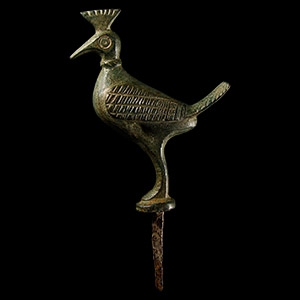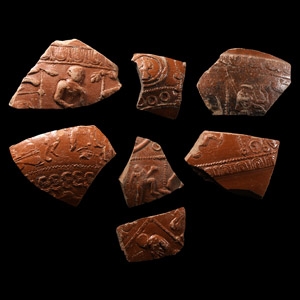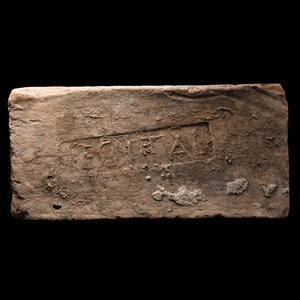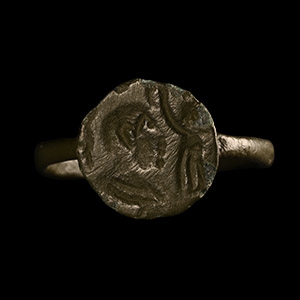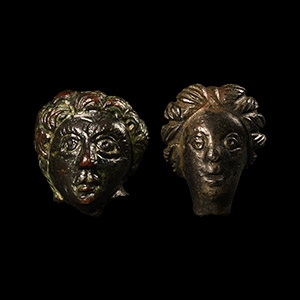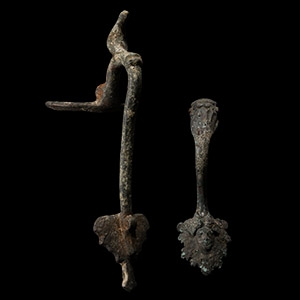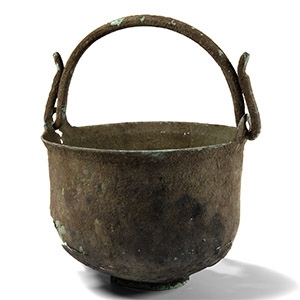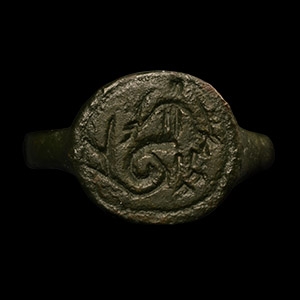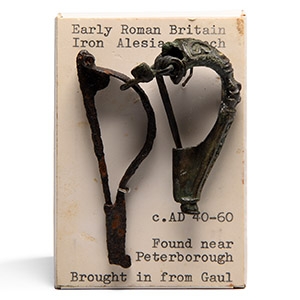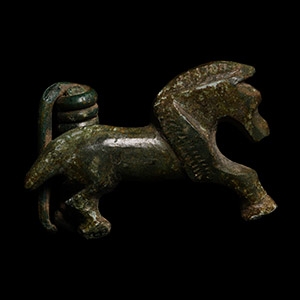Home > Auctions > 23 - 27 May 2023
Ancient Art, Antiquities, Natural History & Coins
Auction Highlights:
Acquired 1990s-early 2000s.
East Anglian private collection.
See Baratta, G., 'Roman Signacula / Una particolare categoria di signacula: marchi per legno, pellame ed animali', in Mayer, M., Olive, G., Baratta, G., Guzman Almagro, A. (ed.), XII Congressus Internationalis Epigraphiae Grecae et Latinae, Barcelona, 2007, pp.99-108, figs.3, 7, for similar stamps.
The signacula used for branding were distinguished primarily by the presence of a relatively long metal arm, which could reach a length of 50 cm. This arm could sometimes be hollow to allow the insertion of a wooden handle. The presence of the long arm constitutes the main indication for the use of these signacula in the context of branding. Its length allowed the user to keep a safe distance from the source of heat.
From the collection of an EU gentleman formed in the early 2000s.
Acquired on the UK market.
Found Billingsgate spoil from the Thames foreshore, London, UK.
Acquired 1960s-1990s.
Late Alison Barker collection, a retired London barrister.
See Sarnowski, T., 'Die Ziegelstempel aus Novae' in Archaeologia, Warszawa, 1983, 43, pp.17-61; Kurzmann, R., 'Soldier, Civilian and Military Brick Production' in Oxford Journal of Archaeology, 24 (4), 2005, pp.405-414.
The Legio I Italica ('of Italy') was a Roman legion formed by Nero on September 20, 66 or 67 A.D. and it was active until the 5th-6th century AD. The emblems of the legion were a running boar and sometimes a bull. Troops of this legion appear on Trajan's Column bridging a river. The main camp of the Legio was Novae, modern Bulgaria, but it operated in most of the imperial provinces, including Britain, where a vexillatio fought in the wars of Septimius Severus between 202 and 204 A.D.
Private collection formed since the 1940s.
UK art market.
Property of an Essex gentleman.
Cf. Chadour, A.B., Rings. The Alice and Louis Koch Collection, volume I, Leeds, 1994, item 447, for type.
Acquired before 2000.
From the collection of a European gentleman living in the UK.
See statuettes with similar heads and dimensions in Politikens Forlag, Jeg ser på oldsager (I look at antiquities), Kopenhagen, 1966, nos.585-586.
Bronze statuettes representing Roman gods and goddesses were widespread all around the empire, and are also known as far as archaeological sites of Jutland and the islands. The two heads represent probably tutela divinities of the home, like Vesta and Juno (Greek Hera).
Acquired 1990s-early 2000s.
East Anglian private collection.
Acquired 1990s-early 2000s.
East Anglian private collection.
Cf. Boucher, S. and Tassinari, S., Bronzes Antiques I, Inscriptions, Statuaire, Vaisselle, Paris, 1976, p.129, no.150, for similar vessel.
Situla (plural situlae), from the Latin word for bucket or pail, is the term in archaeology and art history for a variety of elaborate bucket-shaped vessels from the Iron Age to the Middle Ages, usually with a handle at the top. Roman styles favoured a simple shape curving from the base, becoming vertical at the top, with a wide mouth and no shoulder, but sometimes with a projecting rim. These had a variety of uses, including aiding with washing and bathing.
From the Robin Symes Gallery, stock number 91-321 on label, inventory number 185.
Private collection formed since the 1940s.
UK art market.
Property of an Essex gentleman.
Alesia type found near Peterborough, Cambridgeshire, UK; trumpet type found in Northamptonshire, UK.
Hattatt, R., Ancient Brooches and Other Artefacts, item 1489, and Iron Age and Roman Brooches, pp. 106 & 109.
Hattatt remarks of the Alesia brooch: 'In remarkably fine condition for iron, this could well have been worn by one of the Roman invaders.'
From the collection of a North American gentleman, formed in the 1990s.
505 - 516 of 2508 LOTS

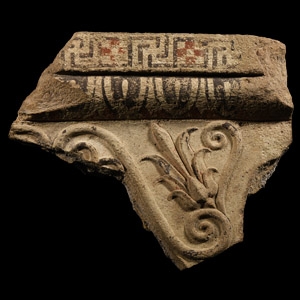
.jpg)


.jpg)
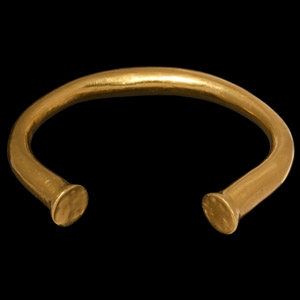
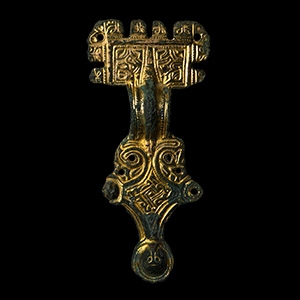

.jpg)
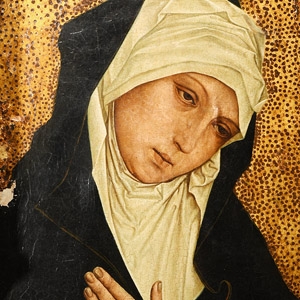

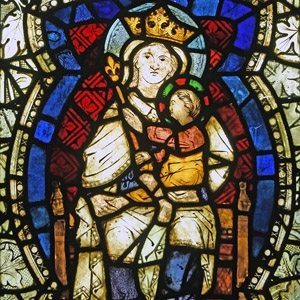
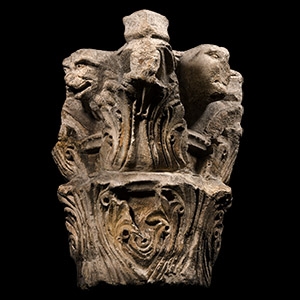
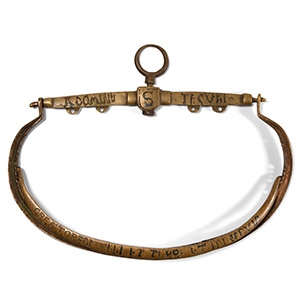
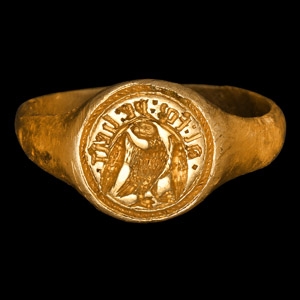
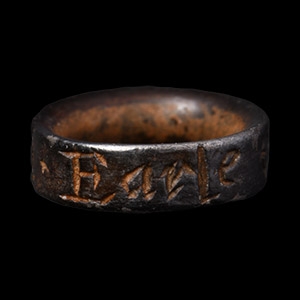
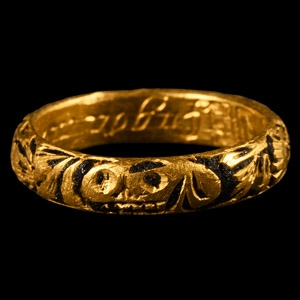
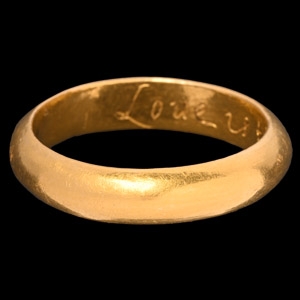
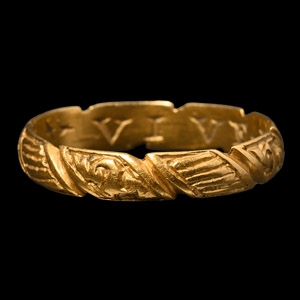
![English Milled Coins - George VI - 1937 - Cased RM Proof Coronation Gold Set [4] English Milled Coins - George VI - 1937 - Cased RM Proof Coronation Gold Set [4]](https://timelineauctions.com/upload/images/items/small/203351-s(2).jpg)

